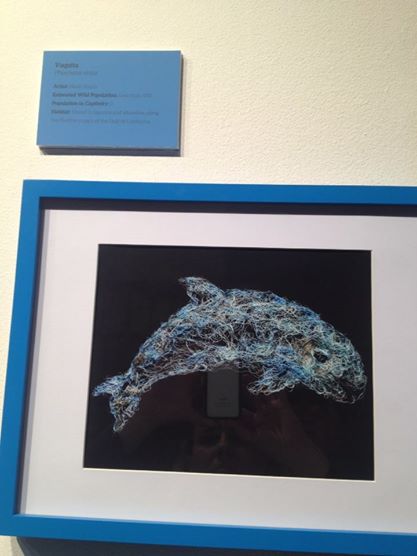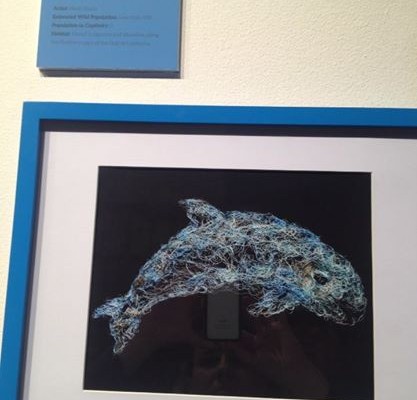By Biologist Abraham Meza López
 The Vaquita Marina (Phocoena sinus) belongs to the family of sea mammals (Phocoenidae) and, along with dolphins and whales, forms part of the cetacean order (Cetacea). The Vaquita is unique across the globe, not only because its entire population is restricted within a reduced area of the Upper Gulf of California – or rather, it is endemic to this region – but also because it is the smallest cetacean on the planet measuring between 1.2 and 1.5 meters long (about 4’ to 5’). Another aspect that brings it global recognition is its extraordinary flexibility to support extreme temperature changes, given the demands of its habitat in the Upper Gulf. No other sea mammal is able to survive such conditions.
The Vaquita Marina (Phocoena sinus) belongs to the family of sea mammals (Phocoenidae) and, along with dolphins and whales, forms part of the cetacean order (Cetacea). The Vaquita is unique across the globe, not only because its entire population is restricted within a reduced area of the Upper Gulf of California – or rather, it is endemic to this region – but also because it is the smallest cetacean on the planet measuring between 1.2 and 1.5 meters long (about 4’ to 5’). Another aspect that brings it global recognition is its extraordinary flexibility to support extreme temperature changes, given the demands of its habitat in the Upper Gulf. No other sea mammal is able to survive such conditions.
The Vaquita Marina is also a matter of global concern as despite always having a small population, it is believed human actions have pushed their numbers to a critical point, and with it the possibility of observing a living example. Only the fortunate who are in the right spot and at the right time have been able to see this species. The vaquita’s low population numbers and rare sightings have created the notion among the local population that the vaquita is a myth, probably a product of one’s imagination, or of governmental agencies. Nevertheless, there is countless proof attesting to its existence, among these: photographs, acoustic records, genetic studies, videos, anecdotes from some locals and visitors, and principally corpses and skeletons, some of which have been preserved in research institutes allowing for comparison with other species in recognizing it is a species distinct from all others.
For some time the vaquita has been confused with dolphins, therefore it is impossible to know the number of sightings prior to it becoming known by the scientific community in 1958. Following its discovery, the vaquita drew the attention of many organizations and scientists who over time understood the risks to the species’ survival. Much has been said about the risks the vaquita faces as an endangered species. Among these is ocean pollution, blockage of fresh water from the Colorado River into the gulf, and endogamy (inbreeding). Yet all of these theories been refuted upon discovering the minimal effect each have on the vaquita’s actual numbers. Still, a threat that to date is considered to have greatly impacted the population is that of gillnets. It is believed that between 40 to 70 vaquitas die each year due to this, while the number of births is much less.
A lot has been done to protect the vaquita, but not enough. In fact, one of the principal goals of the Upper Gulf of California and Colorado River Delta Reserve is that of conserving the vaquita and its habitat. Upon realizing sightings of vaquitas were occurring outside the Reserve polygon, in 2005 the Vaquita Refuge was created. An extensive number of global organizations have also joined the cause, though over time the only solution is that of eradicating the use of gillnets within the Upper Gulf Reserve in reducing the number of deaths to 1 vaquita per year. Though studies have shown their population is quite small, it is still possible to save the vaquita. Around the world there have been cases where endangered species have been able to grow their numbers from dozens to thousands.
Eliminating gillnets does not mean getting rid of fishing in the region, but rather seeking alternatives that benefit the environment and society. As of 2013, through the willingness of authorities, shrimp lines have been substituted with the RS-INP-MEX prototype trawling nets. Unfortunately, these new nets have not been widely accepted among fishermen.
CEDO, through implementation of an Environmental Impact Statement for coastal fishermen within the Reserve, is working on promoting responsible fishing in the region while seeking environmentally – and vaquita – friendly fishing alternatives that allow fishermen to responsibly take advantage of available resources in the region. We hope the Upper Gulf of California will one day be a global example of conservation success. However, we cannot do this alone, we need the help of all; we firmly believe that unity creates strength.
This year the organization Viva Vaquita decided to propose July 12th as the First International Save the Vaquita Day. This is a day to celebrate, raise awareness, open up the world’s eyes, and honor the existence of such a unique being! On Saturday, July 12th, various events were to be held across the globe and CEDO dedicated their Natural History Talk to the Vaquita Marina. Join the celebration!
For more information about the Vaquita, visit CEDO where we’ll be able to clear up questions as well as show you a vaquita skeleton (you can also visit www.cedointercultural.org). Think about something special you can do in the vaquita’s honor in recognizing its existence – publish a note on Facebook, twitter, Instagram, or through any social network, make a poster and share with friends and family, or dedicate a song to the vaquita! ¡Viva la Vaquita!
Biologist Abraham Meza López, CEDO Intercultural Field Station Intern
Edited by: Paloma A. Valdivia Jiménez, CEDO Intercultural Environmental Education Coordinator
